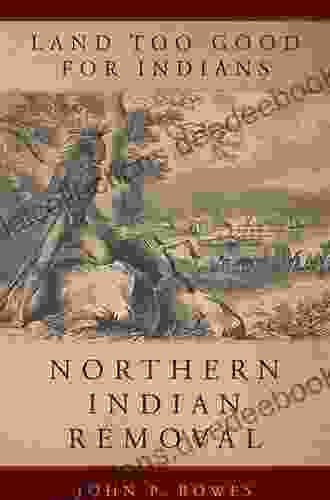Land Too Good For Indians: The Legacy of Colonialism and Native American Dispossession

The land of the United States of America, vast and diverse as it is, holds within its depths a complex and painful history—a history marked by the systematic dispossession of its original inhabitants, the Native American peoples.
4.2 out of 5
| Language | : | English |
| File size | : | 6554 KB |
| Text-to-Speech | : | Enabled |
| Screen Reader | : | Supported |
| Enhanced typesetting | : | Enabled |
| Word Wise | : | Enabled |
| Print length | : | 324 pages |
From the moment European colonizers set foot on these shores, the land became a focal point of conflict and conquest. The colonizers, driven by a relentless drive for expansion and a belief in their own superiority, viewed the land as a resource to be exploited and the Native Americans as obstacles to be removed.
The Doctrine of Discovery
The foundation of the colonizers' claim to the land was laid in the Doctrine of Discovery, a legal principle established by papal bulls in the 15th century. This doctrine gave European powers the right to claim any land that they "discovered" if it was not already occupied by Christians.
The Doctrine of Discovery provided a convenient justification for the colonization of the Americas. European nations, armed with this legalistic fig leaf, embarked on a global campaign of conquest and dispossession.
Forced Removal and Indian Wars
As the colonizers expanded their settlements westward, they encountered resistance from Native American nations determined to protect their lands and way of life. This resistance was met with brutal force.
The United States government waged a series of wars against Native American tribes, culminating in the forced removal of hundreds of thousands of Native Americans from their ancestral homelands.
The Indian Removal Act of 1830 authorized the federal government to negotiate treaties with Native American tribes to exchange their lands east of the Mississippi River for lands west of the river. Many tribes were coerced or deceived into signing these treaties.
Those who resisted were forcibly removed from their homes and marched on long and perilous journeys to reservations in the West. Thousands died along the way, in what became known as the Trail of Tears.
The Dawes Act and Assimilation
In the late 19th century, the United States government implemented a new policy of assimilation aimed at breaking up Native American tribal lands and forcing Native Americans to adopt the ways of white society.
The Dawes Act of 1887 divided reservation lands into individual allotments. The goal was to create a class of Native American farmers who would become self-sufficient and integrated into American society.
However, the Dawes Act had devastating consequences for Native Americans. Many were unable to adapt to the unfamiliar agricultural practices or were cheated out of their land by unscrupulous land speculators.
The Dawes Act also led to the loss of millions of acres of Native American land. By the early 20th century, Native Americans had lost over half of their original landholdings.
The Legacy of Dispossession
The legacy of land dispossession faced by Native Americans is profound and far-reaching. The loss of land has had a devastating impact on Native American cultures, economies, and communities.
Many Native Americans today live in poverty on reservations that are often isolated and underdeveloped. They face high rates of unemployment, disease, and social problems.
The struggle for justice and the recovery of lost lands continues to be a central issue for Native American nations. In recent years, there have been numerous legal battles and protests over land rights, sovereignty, and cultural preservation.
The history of land dispossession faced by Native Americans is a dark chapter in the history of the United States. It is a story of greed, violence, and broken promises.
The legacy of this history continues to shape the lives of Native Americans today. But it is also a story of resilience, resistance, and the ongoing struggle for justice.
4.2 out of 5
| Language | : | English |
| File size | : | 6554 KB |
| Text-to-Speech | : | Enabled |
| Screen Reader | : | Supported |
| Enhanced typesetting | : | Enabled |
| Word Wise | : | Enabled |
| Print length | : | 324 pages |
Do you want to contribute by writing guest posts on this blog?
Please contact us and send us a resume of previous articles that you have written.
 Book
Book Text
Text Story
Story Genre
Genre Paperback
Paperback E-book
E-book Magazine
Magazine Paragraph
Paragraph Sentence
Sentence Bookmark
Bookmark Shelf
Shelf Glossary
Glossary Footnote
Footnote Manuscript
Manuscript Scroll
Scroll Codex
Codex Classics
Classics Autobiography
Autobiography Memoir
Memoir Reference
Reference Encyclopedia
Encyclopedia Dictionary
Dictionary Narrator
Narrator Character
Character Resolution
Resolution Catalog
Catalog Card Catalog
Card Catalog Borrowing
Borrowing Stacks
Stacks Archives
Archives Periodicals
Periodicals Study
Study Research
Research Lending
Lending Academic
Academic Special Collections
Special Collections Study Group
Study Group Dissertation
Dissertation Awards
Awards Textbooks
Textbooks Donna Gielow Mcfarland
Donna Gielow Mcfarland Judith Keim
Judith Keim David R Gamble
David R Gamble Aaron H Oliver
Aaron H Oliver Dr K T Mitchell
Dr K T Mitchell Jaimie Admans
Jaimie Admans Anita Lavi
Anita Lavi David Ulrich
David Ulrich Aaron Agius
Aaron Agius Martha Hamilton
Martha Hamilton Kimberly Kay Hoang
Kimberly Kay Hoang Sandra Rollings Magnusson
Sandra Rollings Magnusson Farhad Taghizadeh Hesary
Farhad Taghizadeh Hesary Leanne Howe
Leanne Howe Jeffrey W Taliaferro
Jeffrey W Taliaferro Edwin Black
Edwin Black Nicola Smith
Nicola Smith Lauren Gross
Lauren Gross Mike Clayton
Mike Clayton Nolan Mccarty
Nolan Mccarty
Light bulbAdvertise smarter! Our strategic ad space ensures maximum exposure. Reserve your spot today!

 Jayson PowellStrengthen Your Family, Simplify Your Homeschool, and Savor the Subjects That...
Jayson PowellStrengthen Your Family, Simplify Your Homeschool, and Savor the Subjects That...
 Samuel BeckettUnleash the Rhythms of Flamenco Ukulele Solos Book 2: A Comprehensive Guide...
Samuel BeckettUnleash the Rhythms of Flamenco Ukulele Solos Book 2: A Comprehensive Guide... Arthur C. ClarkeFollow ·13.7k
Arthur C. ClarkeFollow ·13.7k Beau CarterFollow ·2.6k
Beau CarterFollow ·2.6k Hayden MitchellFollow ·3.3k
Hayden MitchellFollow ·3.3k Corey HayesFollow ·5k
Corey HayesFollow ·5k Hugh BellFollow ·2.7k
Hugh BellFollow ·2.7k Mark TwainFollow ·2.8k
Mark TwainFollow ·2.8k Ralph EllisonFollow ·13.3k
Ralph EllisonFollow ·13.3k Cooper BellFollow ·17.2k
Cooper BellFollow ·17.2k

 Andy Hayes
Andy HayesEmbracing Now: Embark on a Mindfulness Journey for a...
In a world...

 Heath Powell
Heath Powell100 Hymns for Violin and Guitar: A Comprehensive Guide to...
The violin and...

 Floyd Richardson
Floyd RichardsonBark In The Park: Poems For Dog Lovers
Dogs are our best...

 Douglas Adams
Douglas AdamsThe Barter Crusade: A Journey into the Realm of Exchange...
In a world driven by monetary transactions,...

 Nathaniel Hawthorne
Nathaniel HawthorneInsight Guides Explore Nice & the French Riviera...
Prepare to embark on an unforgettable journey...

 Carlos Fuentes
Carlos FuentesThe Ultimate Practical Guide to Percussion: Exploring the...
Embark on a journey into the enchanting...
4.2 out of 5
| Language | : | English |
| File size | : | 6554 KB |
| Text-to-Speech | : | Enabled |
| Screen Reader | : | Supported |
| Enhanced typesetting | : | Enabled |
| Word Wise | : | Enabled |
| Print length | : | 324 pages |








